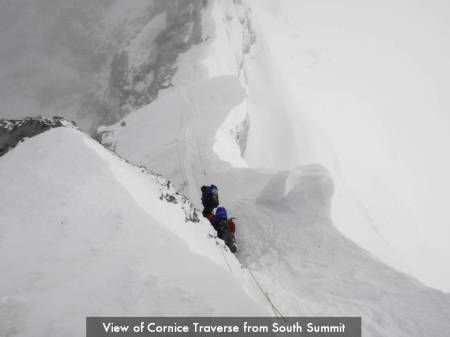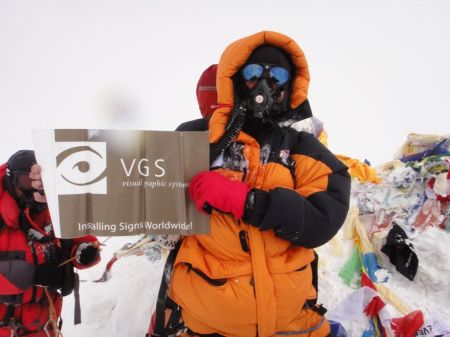[I’m almost done stepping back in time to give you a daily account from the time we left Everest Base Camp on May 17 through the already reported summit on May 24.]
Just below the South Summit there’s a small landing that provided the first real opportunity for a break since our stop at the Balcony. Ang Passang helped me get my pack off and changed out my oxygen bottle to insure I had a sufficient amount to get me to the summit and back to the South Summit cache. I was feeling pretty good. By all accounts, I had conquered the hardest parts of the summit assault and, with the exception of the Hillary Step, had a relatively easy 90 minute climb to my final goal.
As the break ended, Ang Passang helped me get my pack on again (it’s not easy to do when wearing an 8000 meter parka and oxygen mask.) In doing so, he inadvertently pulled the plastic hose feeding oxygen from the regulator my mask — and neither he nor I realized what had happened. I started to proceed towards the summit but after just 3-4 steps, I couldn’t breathe! I didn’t know what was happening but I knew I couldn’t go forward — indeed, I collapsed backwards on to my pack gasping for air and trying to remain calm (not too easy to do!) so as not to exacerbate the situation. Very fortunately, Vern Tejas, who had been assisting Mike Kraft coming up behind me, realized what had happened and ran to my aid. He grabbed the oxygen tube and quickly maneuvered it back into place.
I know the oxygen level at this altitude is just 1/3 of that at sea level, but I would never have guessed that the lack of it would create such immediate consequences. Suffice it to say that I’m in awe of those who have climbed Everest and other 8,000 meter peaks without supplemental oxygen. They have to be superhuman!
With my oxygen flowing again, I picked myself up and continued the final leg of the summit assault, which began with another rock scramble, which was first thought to be the Hillary Step but turned out to be just another unnamed obstacle. After mounting this, we began another intimidating traverse across a knife-edge ridge of snow some 400 feet long. This ridge was done in daylight when you could see the very steep falloffs into Nepal and Tibet — to the left its 8,000 feet down the Southwest Face and to the right, 10,000 feet on the Kangshung Face. I just kept looking forward and had a much better appreciation of the Sherpa Team that placed the anchors and fixed ropes in early May.
Immediately ahead of our break point was what everyone first thought was the Hillary Step — but it wasn’t. It was just another unnamed rock scramble. Once above this obstacle, we could see the real Hillary Step, although it didn’t appear that much more difficult — and I don’t think it was. It’s steep and rocky, but it was easy to jockey up using your ascender and some good footholds. There is one point where you have to straddle a huge boulder and then carefully jump one foot into a 6” wide crack below. Maneuvering around this boulder caused a bottleneck, but there were relatively few climbers this day, so it wasn’t a big problem.
Above the Hillary Step, the trek to the summit was easy, although that’s a relative term. You still have to take 3-4 breaths for each step and just plow on — but you’re on a beautiful ridge and can see the crowd (20-30 people were ahead of me, including my teammates) sitting just to the side of the summit. More importantly, you know with certainty that you’re going to reach it after eight weeks of waiting!
I’m embarrassed to say it felt a bit anti-climatic! After eleven hours of exhausting climbing, I simply hugged Ang Passang and then sat down and took in the limited view (it was too cloudy to see anything farther than the south summit). Mike Kraft joined me and we looked on with some surprise as another climber came up behind us from Tibet! We took some photos with our trusty Sherpa guides and I tried to call Joyce on a satellite phone (I could hear her but she couldn’t hear me but later learned she was sure it was me given the call came through after midnight in NYC).

Before I knew what was happening, Lakpa Rita Sherpa was yelling at our team to “…get down before the weather turns — it’s dangerous to stay here.” Only then did I realize I hadn’t taken pictures with the banners I had laboriously carried from Base Camp. Fortunately, Garrett Madison (the AAI expedition leader) came to my rescue. He pulled the banners out of my pack, grabbed my camera and started shooting. He then whisked me off the summit and I tried, to no avail, to catch up to my teammates who had run ahead. Ang Passang and another Sherpa, Dorje, followed in front and behind me to insure my descent was a safe one and their assistance was greatly appreciated.
Just how difficult the ascent was did not hit home until I recently read that the distance from Camp 4 to the summit is just 1.07 miles. I was incredulous. It took me eleven hours (which was slower than four of my younger teammates who made it in 9-1/2 hours, but still a respectable time when you consider that some climbers take up to 16 hours). In other words, my average speed was just a tenth of a mile per hour. It sounds almost impossible to go that slow, but you have to realize that you take 4-5 breaths after each step and that the better part of the climb is VERY steep.

Gravity works in your favor going down, although you are quite exhausted from the ordeal of ascending, which is why most mountaineering accidents occur going down rather than up. But thanks to my invaluable Sherpa, my descent was uneventful and took just four hours. However, during the last half-hour, which is on a smooth snow slope leading into to Camp 4, my legs started to get a bit shaky. Seeing I could do with some help, Dorje, who had been assisting me clipping in an out of the ropes on the steeper sections of the descent, grabbed my hand and looked at me with a broad smile on his face. I was especially touched by this act of kindness. It was just the boost I needed after a physically and emotionally exhausting day and we happily walked hand in hand as he escorted me the remainder of the way to my tent.
It was only 1:15 PM, but I had been awake almost 24 hours and climbing or descending for 15 hours. I slipped into my sleeping bag but the exhilaration I felt (or perhaps it was the endorphins running through my veins) made it impossible to sleep. It was a nice afternoon!
//Don








 Posted by everesthiphop
Posted by everesthiphop 










